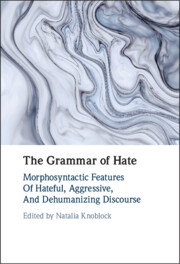Book contents
- The Grammar of Hate
- The Grammar of Hate
- Copyright page
- Contents
- Figures
- Tables
- Contributors
- Acknowledgments
- Introduction
- 1 Animacy and Countability of Slurs
- 2 Language Aggression in English Slang: The Case of the -o Suffix
- 3 Adj+ie/y Nominalizations in Contemporary English
- 4 Grammatical Gender and Offensiveness in Modern Greek Slang Vocabulary
- 5 Unseen Gender
- 6 The Neutering Neuter
- 7 Neutering Unpopular Politicians
- 8 The Power of a Pronoun
- 9 Is Play on Words Fair Play or Dirty Play?
- 10 Expressive German Adjective and Noun Compounds in Aggressive Discourse
- 11 ‘Kill the Invaders’
- 12 ‘I am no racist but …’
- 13 Homophobic Space–Times
- Index
- References
10 - Expressive German Adjective and Noun Compounds in Aggressive Discourse
Morphopragmatic and Sociolinguistic Evidence from Austrian Corpora
Published online by Cambridge University Press: 30 June 2022
- The Grammar of Hate
- The Grammar of Hate
- Copyright page
- Contents
- Figures
- Tables
- Contributors
- Acknowledgments
- Introduction
- 1 Animacy and Countability of Slurs
- 2 Language Aggression in English Slang: The Case of the -o Suffix
- 3 Adj+ie/y Nominalizations in Contemporary English
- 4 Grammatical Gender and Offensiveness in Modern Greek Slang Vocabulary
- 5 Unseen Gender
- 6 The Neutering Neuter
- 7 Neutering Unpopular Politicians
- 8 The Power of a Pronoun
- 9 Is Play on Words Fair Play or Dirty Play?
- 10 Expressive German Adjective and Noun Compounds in Aggressive Discourse
- 11 ‘Kill the Invaders’
- 12 ‘I am no racist but …’
- 13 Homophobic Space–Times
- Index
- References
Summary
In this morphopragmatic and sociolinguistic contribution, the use of expressive German adjective and noun compounds is investigated in two Austrian corpora, an oral corpus of informal conversations among adults of different sociodemographic backgrounds and a written newspaper corpus. For the qualitative analysis, the study differentiates between direct and indirect aggressive discourse. Although sets of compounds with identical second adjective constituent are denotatively synonymic, the denotative meaning of the second constituent, whereas the first constituent has largely lost its denotative in favour of connotative meaning. Therefore, there is no lexical blocking among the sets of adjectival compounds which have changed into morphopragmatic semiprefixations. Quantitative results show that pejorative expressive compounds are more frequent than meliorative ones. Expressive noun compounds are more frequent in aggressive discourse, although expressive adjective compounds have a higher overall frequency. In informal conversations, direct insults and self-insults are rare, but indirect negative assessments of other persons and complaints about awkward situations prevail. A gender trend indicates that women use slightly fewer negative expressive compounds than men, and an SES effect shows that participants with lower educational levels use fewer positive expressive compounds.
- Type
- Chapter
- Information
- The Grammar of HateMorphosyntactic Features of Hateful, Aggressive, and Dehumanizing Discourse, pp. 197 - 221Publisher: Cambridge University PressPrint publication year: 2022
References
- 1
- Cited by



